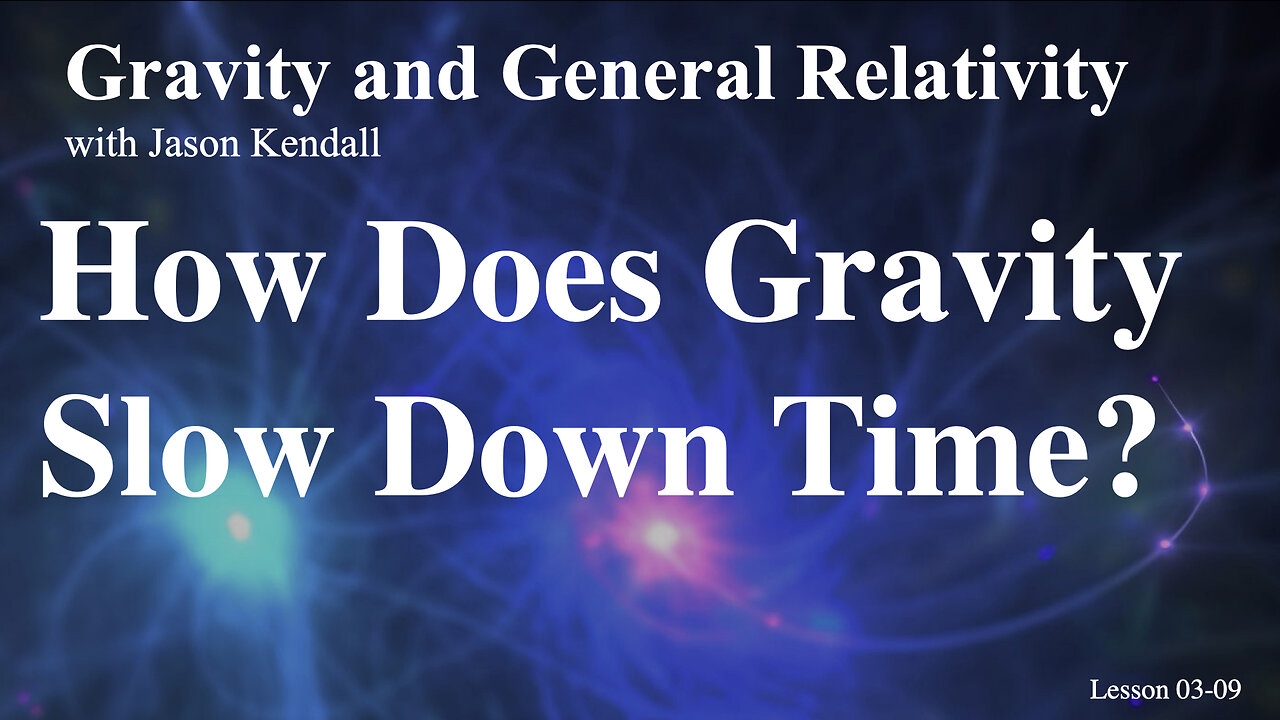Premium Only Content

Understanding General Relativity: The Bending of Light and the Equivalence Principle
In this lecture, we delve into the fundamental concepts of general relativity, particularly focusing on the principle of equivalence and its implications. General relativity, formulated by Albert Einstein, revolutionized our understanding of gravity, light, and the structure of space-time. At the core of this theory lies the principle of equivalence, which posits that gravitational and inertial forces are locally indistinguishable. This idea leads us to explore various scenarios that illustrate the bending of light due to gravity and the resulting implications for our understanding of the universe. Einstein’s principle of equivalence can be illustrated through two pairs of scenarios that showcase how gravity and acceleration produce similar effects. The first scenario involves a person floating in space, far from any gravitational influence, and the second involves an individual in free fall within a gravitational field. In both cases, the individual experiences weightlessness; there is no discernible difference in their experience. This equivalence implies that falling freely through a gravitational field is indistinguishable from floating in deep space. The second pair of scenarios involves a person standing on the surface of the Earth and another person in a rocket that is accelerating upwards at the same rate as gravitational acceleration. In both instances, the individuals feel a force pushing them downwards, which can be interpreted as weight. However, it is essential to note that the principle of equivalence is applicable only in what we define as locally inertial reference frames. Therefore, while the experiences may seem similar, the gravitational effects differ when considered over larger distances, such as in a 200-mile-long spaceship. To further illustrate the principle of equivalence, we can conduct an experiment involving a laser beam. When we shine a laser across a room in a gravitational field, the beam bends slightly downward due to the curvature of space-time caused by gravity. This bending is minuscule—on the order of a light year for significant distances—but it is a clear demonstration of how gravity influences the path of light. When the laser is directed upwards in the same gravitational field, the situation changes. If we consider an observer in deep space who sees the laser being fired upwards, they would notice that the ceiling of the room descends as the laser travels upward. Consequently, the light beam would reach the ceiling in a shorter distance than anticipated, resulting in a blue shift observed by the distant observer. However, the person firing the laser, who is in a freely falling reference frame, sees no change in the wavelength of the light due to the equivalence principle. This leads us to the concept of gravitational redshift, which describes the phenomenon where light loses energy as it climbs out of a gravitational field. Thus, while the distant observer perceives the upward laser beam as blue-shifted due to the downward movement of the ceiling, the person firing the laser does not notice any change. For this to occur, there must be a gravitational redshift that perfectly counteracts the blue shift experienced by the distant observer. Upon reaching the surface of the Earth, where gravitational effects are constant, if a laser is fired upwards, it is expected that the light received at the top of a tall building will exhibit a redshift. This gravitational redshift has been experiment ally confirmed and serves as a testament to the influence of gravity on light. In another scenario, if a person is in a rocket accelerating upwards, they would perceive the same gravitational redshift as when standing on the Earth’s surface. An observer outside the rocket would notice that the light emitted from the rocket experiences a redshift due to the upward acceleration. This scenario exemplifies the equivalence of being in a gravitational field and being in an accelerating frame of reference. The implications of these observations extend beyond mere theoretical discussions. They have practical consequences, particularly in modern technology such as the Global Positioning System (GPS). The time dilation effects experienced by satellites in orbit must be accounted for to ensure accurate positioning, as the clocks on the satellites run faster than those on Earth due to their altitude and relative motion. The relationship between light and gravity illustrates how space-time is curved by the presence of mass. Light always travels along the straightest path available in curved space-time, and as such, its trajectory is altered by gravitational fields. This bending of light provides compelling evidence for the curvature of space-time as proposed by Einstein. To further understand the nature of space-time curvature, we can reference the Schwarzschild metric, which describes the geometry around a spherical, non-rotating mass. This metric allows us to derive Newtonian gravity in a weak field limit, demonstrating that general relativity and classical mechanics are interconnected. The Schwarzschild metric shows how space and time change as one approaches a massive object, further reinforcing the idea that gravity affects the flow of time and the geometry of space. An alternative conceptual model for understanding space-time curvature is to visualize it as a flowing river. In this analogy, light behaves like a fish swimming upstream against the current of space-time that flows towards mass. As light attempts to navigate this current, it loses energy, which manifests as a redshift. This visualization provides an intuitive understanding of how space-time interacts with light and mass. In conclusion, the principles of general relativity and the equivalence principle reveal profound insights into the nature of gravity and its effects on light and time. The bending of light in gravitational fields, the phenomenon of gravitational redshift, and the practical implications of these concepts in modern technology underscore the importance of understanding general relativity. As we continue to explore the universe and the fundamental forces that govern it, the principles of general relativity will remain essential to our scientific inquiry and comprehension of the cosmos.
-
 10:14:18
10:14:18
Dr Disrespect
12 hours ago🔴LIVE - DR DISRESPECT - ARC RAIDERS - AGAINST ALL DANGER
147K22 -
 32:09
32:09
ThisIsDeLaCruz
23 hours agoFalling In Reverse: Christian Thompson’s Stage Tech Revealed
3.25K2 -
 LIVE
LIVE
SynthTrax & DJ Cheezus Livestreams
1 day agoFriday Night Synthwave 80s 90s Electronica and more DJ MIX Livestream 80s Night / Late Night Nostalgia
196 watching -
 4:05:52
4:05:52
Nerdrotic
7 hours ago $0.15 earnedHollywood REGRET | Disney's Predator | The Feminist Avengers - Friday Night Tights 379
36.9K12 -
 DVR
DVR
Mally_Mouse
4 days agoFriend Friday!! 🎉 - Let's Play! - MIMESIS
5.13K2 -
 41:20
41:20
MattMorseTV
3 hours ago $0.19 earned🔴Schumer just BACKSTABBED his OWN VOTERS. 🔴
18.9K39 -

MissesMaam
4 hours ago*Spicy* Friend Friday with Mally_Mouse!! 💚✨
2.71K3 -
 57:44
57:44
Candace Show Podcast
4 hours agoBen Shapiro Is Crying Again. | Candace Ep 261
43.2K175 -
 LIVE
LIVE
megimu32
3 hours agoOFF THE SUBJECT: MEMESIS w/ MALLY MOUSE | MISSES MAAM | SAVAGEJAYGATSBY
48 watching -
 LIVE
LIVE
a12cat34dog
3 hours agoI AM FINALLY BACK | Dying Light: The Beast x PUBG | COLLABORATION EVENT {18+}
48 watching